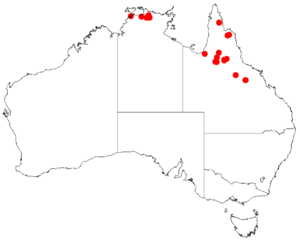Acacia armitii facts for kids
Acacia armitii is a type of shrub or small tree. It belongs to a large group of plants called Acacia, also known as wattles. This plant is special because it grows naturally only in certain parts of north-eastern Australia. Scientists consider it "near threatened" in Queensland, which means it needs protection to make sure it doesn't disappear.
Quick facts for kids Acacia armitii |
|
|---|---|
| Scientific classification | |
| Genus: |
Acacia
|
| Species: |
armitii
|
 |
|
| Occurrence data from AVH | |
What Does Acacia armitii Look Like?
This slender plant can grow as a small tree or a shrub. It usually reaches a height of about 7.5 meters (about 25 feet). Its young branches are smooth and have a fawn or yellow color. They also have clear angles. The bark on the main trunk and branches is grey and has cracks.
Like most Acacia plants, it has special leaf-like parts called phyllodes instead of true leaves. These phyllodes are yellowish-green and feel a bit sticky because of resin. They stand upright and can be flat and straight or slightly curved. Their shape is like a very narrow oval or almost a line.
The phyllodes are quite stiff but can bend. They are usually between 4.5 and 17 centimeters (about 1.8 to 6.7 inches) long. They are also between 3.5 and 17 millimeters (about 0.14 to 0.67 inches) wide. Each phyllode has one main yellowish vein in the middle. It also has two less clear veins on each side, plus four to eight smaller veins running parallel.
This plant blooms, meaning it produces flowers, during two main periods. You can see its flowers between June and July. It also blooms again between September and October.
Where Did Its Name Come From?
The specific name, armitii, was chosen to honor a person named William Edington (de Marguerittes) Armit. He lived from 1848 to 1901.
Where Does Acacia armitii Grow?
Acacia armitii is an endemic plant. This means it grows naturally only in specific areas. You can find it around the Einasleigh River in central-northern Queensland. It also grows on a sandstone plateau south of Goomadeer.
Additionally, it is found along Coopers Creek near Nabarlek in the Northern Territory. This plant prefers to grow in rocky, sandy, or shallow soils. It is often found along the banks of creeks and on river flats or floodplains.

